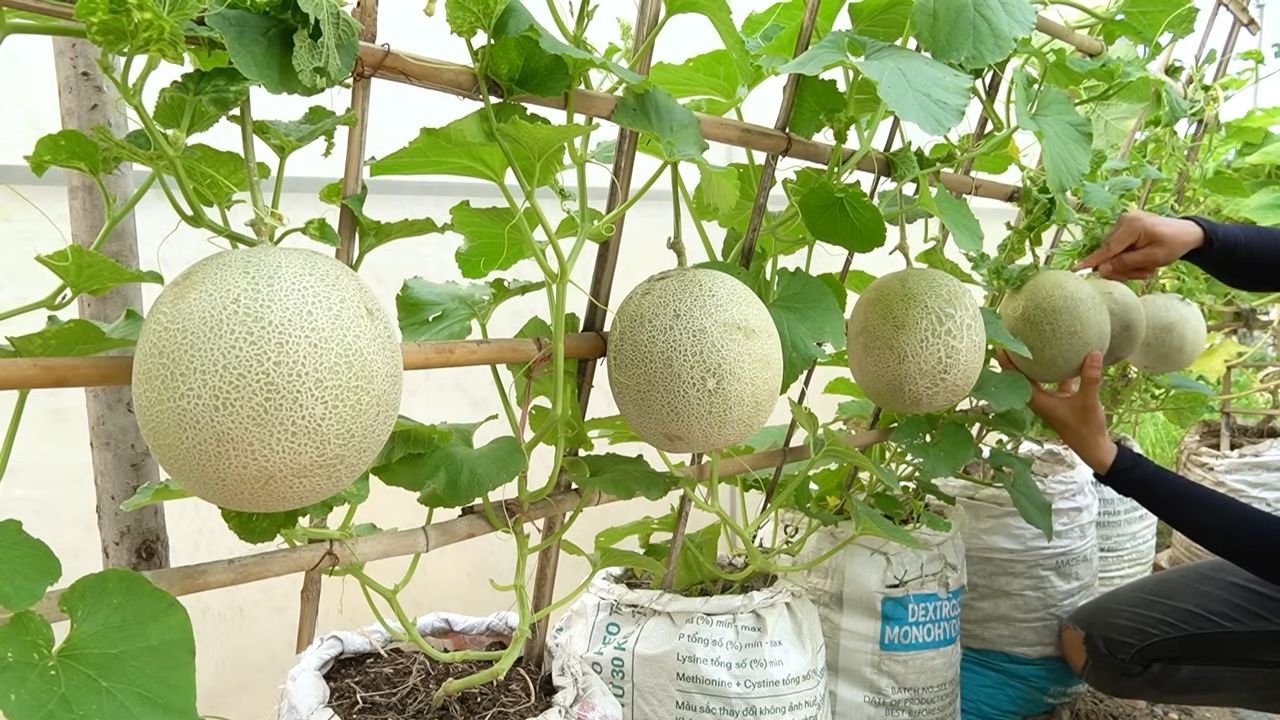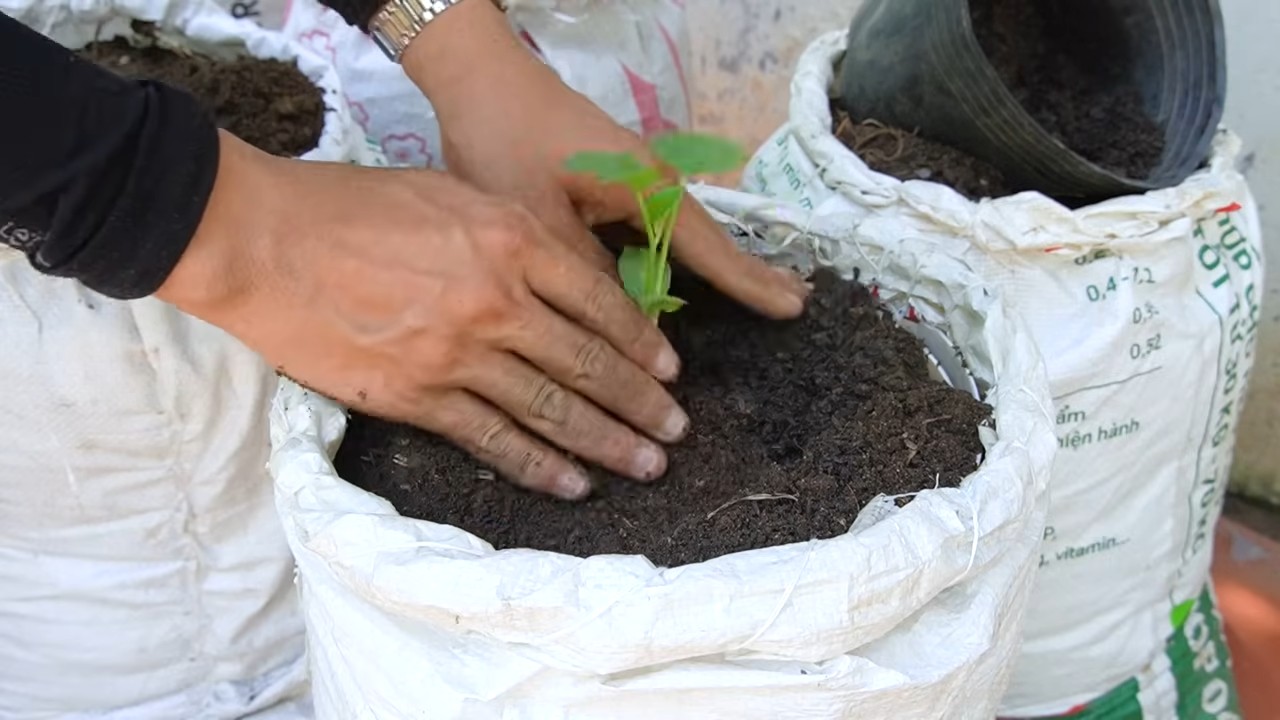Grow cantaloupe in grow bags? Absolutely! Imagine biting into a juicy, sweet cantaloupe that you nurtured from seed to fruit, right on your patio or balcony. Forget sprawling vines taking over your garden; this DIY guide unlocks the secret to enjoying homegrown cantaloupe even with limited space. For centuries, cantaloupe has been cherished for its refreshing flavor and nutritional benefits, gracing tables from ancient Egypt to modern-day picnics. But what if you don’t have a sprawling garden to dedicate to this sun-loving melon?
That’s where the magic of grow bags comes in! Many people struggle with traditional gardening due to space constraints, poor soil quality, or simply the overwhelming commitment of a large garden plot. This DIY trick solves all of that. I’m going to show you how to successfully grow cantaloupe in grow bags, offering a practical and rewarding solution for urban gardeners and anyone looking to maximize their harvest in a small space. Get ready to learn simple steps, from choosing the right grow bag to providing the perfect care, and transform your limited space into a cantaloupe haven!

Growing Cantaloupe in Grow Bags: A Sweet Success Story!
Hey there, fellow gardening enthusiasts! I’m so excited to share my experience growing cantaloupe in grow bags. I know, I know, it sounds a little unconventional, but trust me, it’s totally doable and can be incredibly rewarding. If you’re short on space, have poor soil, or just want to try something new, growing cantaloupe in grow bags might just be your new favorite gardening hack!
Why Grow Bags for Cantaloupe?
Before we dive into the nitty-gritty, let’s talk about why grow bags are a fantastic option for cantaloupe:
* Excellent Drainage: Cantaloupe hates soggy roots. Grow bags provide superior drainage compared to traditional containers, preventing root rot and promoting healthy growth.
* Air Pruning: The fabric of grow bags allows air to circulate around the roots, naturally pruning them. This encourages a denser, more fibrous root system, leading to a stronger and healthier plant.
* Portability: Need to move your cantaloupe to a sunnier spot? No problem! Grow bags are lightweight and easy to move around, giving you flexibility in your garden.
* Space Saving: If you’re like me and have limited garden space, grow bags are a lifesaver. You can grow cantaloupe on patios, balconies, or even decks.
* Warmer Soil: The dark fabric of grow bags absorbs heat, warming the soil faster in the spring and extending the growing season.
Choosing the Right Grow Bag and Variety
Okay, so you’re convinced about grow bags. Awesome! Now, let’s talk about selecting the right grow bag and cantaloupe variety.
* Grow Bag Size: This is crucial! Cantaloupe needs plenty of room for its roots to spread. I recommend a grow bag that’s at least 20 gallons in size, but 25-30 gallons is even better. The bigger, the better, really!
* Fabric Type: Look for grow bags made from a breathable, non-woven fabric. This will ensure good drainage and air circulation.
* Cantaloupe Variety: Not all cantaloupe varieties are created equal when it comes to container gardening. Smaller, bush-type varieties are generally better suited for grow bags. Here are a few of my favorites:
* Minnesota Midget: This is a classic choice for small spaces. It produces small, sweet cantaloupes that are perfect for one or two people.
* Bush Star: As the name suggests, this is a compact, bush-type variety that’s ideal for containers.
* Sugar Cube: Another great option for smaller gardens, Sugar Cube produces small, round cantaloupes with a high sugar content.
* Jenny Lind: This heirloom variety produces flattened, turban-shaped cantaloupes with a unique flavor.
Materials You’ll Need
Before we get started, let’s gather all the necessary materials:
* Grow bag (20-30 gallons)
* High-quality potting mix (not garden soil!)
* Cantaloupe seeds or seedlings
* Slow-release fertilizer
* Watering can or hose
* Trellis or support structure (optional, but highly recommended)
* Gardening gloves
* Hand trowel
Step-by-Step Guide to Growing Cantaloupe in Grow Bags
Alright, let’s get our hands dirty! Here’s a step-by-step guide to growing cantaloupe in grow bags:
1. Preparing the Grow Bag
1. Choose a Sunny Location: Cantaloupe needs at least 6-8 hours of direct sunlight per day. Select a spot in your garden or on your patio that gets plenty of sunshine.
2. Place the Grow Bag: Position the empty grow bag in your chosen location. Once it’s filled with soil, it will be heavy and difficult to move.
3. Fill with Potting Mix: Fill the grow bag with high-quality potting mix, leaving about 2-3 inches of space at the top. Don’t use garden soil, as it can compact and doesn’t drain well in containers.
4. Incorporate Fertilizer: Mix a slow-release fertilizer into the top layer of the potting mix. Follow the instructions on the fertilizer package for the correct amount.
2. Planting the Cantaloupe
1. Starting from Seed: If you’re starting from seed, sow 2-3 seeds per grow bag, about 1 inch deep. Keep the soil moist but not soggy. Once the seedlings emerge, thin them to one strong plant per bag.
2. Transplanting Seedlings: If you’re using seedlings, gently remove them from their containers and plant them in the center of the grow bag. Make sure the top of the root ball is level with the soil surface.
3. Water Thoroughly: After planting, water the cantaloupe thoroughly to settle the soil and help the roots establish.
3. Providing Support
1. Install a Trellis: Cantaloupe vines can get quite long and heavy, so providing support is essential. Install a trellis or other support structure near the grow bag. You can use a tomato cage, a wooden trellis, or even a DIY structure made from bamboo stakes and twine.
2. Train the Vines: As the cantaloupe vines grow, gently train them to climb the trellis. You can use plant ties or twine to secure the vines to the support structure. This will help keep the fruit off the ground and prevent rot.
4. Watering and Fertilizing
1. Water Regularly: Cantaloupe needs consistent moisture, especially during hot weather. Water deeply whenever the top inch of soil feels dry to the touch. Avoid overwatering, as this can lead to root rot.
2. Fertilize Regularly: Cantaloupe is a heavy feeder, so it needs regular fertilization. Apply a liquid fertilizer every 2-3 weeks, following the instructions on the fertilizer package. Choose a fertilizer that’s high in phosphorus and potassium, which are essential for fruit development.
5. Pollination
1. Hand Pollination (If Necessary): Cantaloupe relies on bees and other pollinators to produce fruit. If you’re not seeing many bees in your garden, you may need to hand-pollinate the flowers. To do this, use a small paintbrush to transfer pollen from the male flowers to the female flowers. Female flowers have a small fruit developing behind the flower, while male flowers do not.
6. Pest and Disease Control
1. Monitor for Pests: Keep an eye out for common cantaloupe pests, such as aphids, squash bugs, and cucumber beetles. If you spot any pests, treat them with an appropriate insecticide or organic pest control method.
2. Prevent Diseases: Cantaloupe is susceptible to several diseases, including powdery mildew and fusarium wilt. To prevent these diseases, provide good air circulation, avoid overwatering, and use disease-resistant varieties.
7. Harvesting Your Cantaloupe
1. Check for Ripeness: Knowing when to harvest cantaloupe can be tricky. Here are a few signs that your cantaloupe is ripe:
* The stem starts to slip easily from the fruit.
* The skin turns from green to a tan or yellowish color.
* The cantaloupe has a sweet, musky aroma.
2. Harvest Carefully: Once the cantaloupe is ripe, gently twist it from the vine. Be careful not to damage the fruit.
3. Enjoy Your Harvest: Cut open your homegrown cantaloupe and enjoy its sweet, juicy flavor!
Troubleshooting Tips
Even with the best planning, things can sometimes go wrong. Here are a few common problems you might encounter and how to fix them:
* Yellowing Leaves: This could be a sign of overwatering, underwatering, or nutrient deficiency. Check the soil moisture and adjust your watering schedule accordingly. Fertilize with a balanced fertilizer to provide essential nutrients.
* Lack of Fruit: This could be due to poor pollination. Try hand-pollinating the flowers or attracting more bees to your garden by planting bee-friendly flowers.
* Small Fruit: This could be caused by insufficient watering or fertilization. Make sure you’re watering deeply and fertilizing regularly.
* Root Rot: This is usually caused by overwatering. Make sure your grow bag has good drainage and avoid watering too frequently.
Final Thoughts
Growing cantaloupe in grow bags is a fun and rewarding experience. With a little planning and care, you can enjoy delicious, homegrown cantaloupe even if you have limited space. So, give it a try and let me know how it goes! Happy gardening!

Conclusion
So, there you have it! Growing cantaloupe in grow bags is not just a possibility; it’s a pathway to a bountiful harvest, even if you’re short on space or dealing with less-than-ideal soil conditions. We’ve walked through the process, from selecting the right grow bag size and choosing the perfect cantaloupe variety to nurturing your plants with proper watering, feeding, and support.
But why is this DIY trick a must-try? It boils down to control, convenience, and exceptional results. Grow bags offer superior drainage and aeration compared to traditional garden beds, preventing root rot and fostering healthier, more vigorous growth. The portability of grow bags allows you to chase the sun, shield your plants from unexpected frosts, and even move them indoors if necessary. Plus, you have complete control over the soil composition, ensuring your cantaloupes receive the precise nutrients they need to thrive.
Consider these variations to personalize your cantaloupe growing experience:
* Vertical Support Systems: Experiment with different trellising methods. A sturdy tomato cage or a custom-built trellis can provide excellent support for your growing vines and keep the fruit off the ground, reducing the risk of pests and diseases.
* Companion Planting: Enhance your grow bag ecosystem by planting companion plants like marigolds (to deter pests) or basil (to improve flavor).
* Succession Planting: Extend your harvest season by planting cantaloupe seeds in staggered intervals, ensuring a continuous supply of delicious fruit throughout the summer.
* Different Cantaloupe Varieties: Don’t limit yourself to just one type of cantaloupe! Explore different varieties like ‘Athena,’ ‘Hales Best Jumbo,’ or ‘Honey Rock’ to discover your personal favorite. Each variety offers a unique flavor profile and growth habit.
* DIY Soil Mixes: While a standard potting mix works well, you can create your own custom blend by combining compost, peat moss, perlite, and vermiculite. This allows you to tailor the soil composition to the specific needs of your chosen cantaloupe variety.
Growing cantaloupe in grow bags is a rewarding experience that connects you with nature and provides you with fresh, homegrown fruit. It’s a project that’s accessible to gardeners of all skill levels, from beginners to seasoned pros. The satisfaction of harvesting your own sweet, juicy cantaloupe is truly unmatched.
We wholeheartedly encourage you to give this DIY trick a try. Don’t be afraid to experiment, adapt, and learn along the way. Gardening is a journey, and every season brings new opportunities for growth and discovery.
And most importantly, we want to hear about your experiences! Share your photos, tips, and challenges in the comments below. Let’s create a community of cantaloupe enthusiasts and learn from each other’s successes and failures. Your insights could inspire others to embark on their own grow bag adventures. Happy gardening!
Frequently Asked Questions (FAQ)
What size grow bag is best for growing cantaloupe?
The ideal grow bag size for cantaloupe is typically 15-25 gallons. This provides ample space for the root system to develop and ensures the plant has access to sufficient nutrients and water. While smaller grow bags (10 gallons) might work for dwarf varieties, larger bags are generally recommended for optimal growth and fruit production. Remember that larger bags will also retain moisture longer, so adjust your watering schedule accordingly.
How often should I water my cantaloupe plants in grow bags?
Watering frequency depends on several factors, including the weather, the size of the grow bag, and the stage of plant growth. Generally, you should water your cantaloupe plants when the top inch of soil feels dry to the touch. During hot, sunny weather, you may need to water daily, while cooler, cloudier days may require less frequent watering. Avoid overwatering, as this can lead to root rot. A good rule of thumb is to water deeply and thoroughly, allowing excess water to drain from the bottom of the grow bag.
What type of soil should I use in my grow bags for cantaloupe?
A well-draining potting mix is essential for growing cantaloupe in grow bags. Avoid using garden soil, as it can be too heavy and compact, hindering root growth. A good potting mix typically consists of peat moss, perlite, vermiculite, and compost. You can also add slow-release fertilizer to provide a steady supply of nutrients. Consider amending your soil with aged manure or worm castings for added fertility and improved drainage.
Do I need to fertilize my cantaloupe plants in grow bags?
Yes, fertilizing is crucial for healthy cantaloupe growth and abundant fruit production. Use a balanced fertilizer (e.g., 10-10-10) during the early stages of growth, and then switch to a fertilizer with a higher phosphorus and potassium content (e.g., 5-10-10) once the plants begin to flower and set fruit. Apply fertilizer according to the package instructions, and avoid over-fertilizing, as this can burn the roots. Liquid fertilizers can be applied directly to the soil, while granular fertilizers can be incorporated into the soil mix.
How do I support my cantaloupe vines in grow bags?
Cantaloupe vines can become quite heavy, especially when laden with fruit. Providing support is essential to prevent the vines from sprawling on the ground and to protect the fruit from pests and diseases. You can use a trellis, tomato cage, or other support structure to train the vines vertically. Secure the vines to the support structure using plant ties or twine. Make sure the support structure is sturdy enough to withstand the weight of the mature vines and fruit.
How do I know when my cantaloupe is ripe?
Determining when a cantaloupe is ripe can be tricky, but there are several indicators to look for. The most reliable sign is the development of a crack around the stem where it attaches to the fruit. The skin color should also change from green to a tan or yellow hue, depending on the variety. The cantaloupe should also have a fragrant aroma. Gently press on the blossom end of the fruit; it should feel slightly soft and yield to gentle pressure. If the cantaloupe meets all of these criteria, it’s likely ripe and ready to harvest.
What are some common pests and diseases that affect cantaloupe plants in grow bags?
Common pests that can affect cantaloupe plants include aphids, squash bugs, cucumber beetles, and spider mites. Diseases include powdery mildew, downy mildew, and fusarium wilt. Regularly inspect your plants for signs of pests or diseases, and take action promptly to prevent them from spreading. Insecticidal soap, neem oil, and copper fungicide can be used to control pests and diseases. Ensure good air circulation around your plants to minimize the risk of fungal diseases.
Can I grow cantaloupe in grow bags indoors?
Yes, you can grow cantaloupe in grow bags indoors, but it requires providing adequate light and pollination. You’ll need a strong grow light to mimic sunlight, ideally a full-spectrum LED grow light. You’ll also need to hand-pollinate the flowers, as there won’t be any bees or other pollinators indoors. Use a small paintbrush to transfer pollen from the male flowers to the female flowers. Indoor growing can be more challenging than outdoor growing, but it’s possible with the right equipment and care.
How many cantaloupe plants can I grow in one grow bag?
It’s generally recommended to grow only one cantaloupe plant per grow bag, especially if you’re using a 15-25 gallon bag. Crowding multiple plants in a single bag can lead to competition for resources, stunted growth, and reduced fruit production. Giving each plant its own dedicated space allows it to thrive and reach its full potential.
What are the benefits of using grow bags compared to traditional gardening methods for cantaloupe?
Grow bags offer several advantages over traditional gardening methods for cantaloupe:
* Improved Drainage and Aeration: Grow bags allow for better drainage and aeration, preventing root rot and promoting healthier root growth.
* Portability: Grow bags can be easily moved to chase the sun or protect plants from frost.
* Soil Control: You have complete control over the soil composition, ensuring your cantaloupes receive the precise nutrients they need.
* Space Saving: Grow bags are ideal for gardeners with limited space, such as balconies or patios.
* Reduced Weeding: Grow bags minimize weed growth, as the soil is contained within the bag.
* Warmer Soil Temperatures: Grow bags tend to warm up faster than garden soil, which can be beneficial for cantaloupe, which prefers warm temperatures.





Leave a Comment